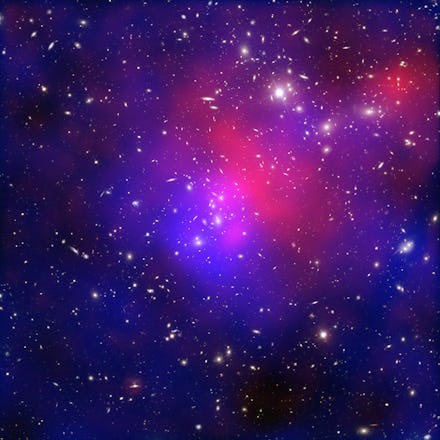Scientists found a galaxy that’s 99.99% dark matter

Astronomers have found a galaxy that is made almost entirely of a mysterious, invisible substance called dark matter. The discovery could help us finally figure out what dark matter is made of and prove that it really exists.
The dark matter galaxy is called Dragonfly 44. It's roughly the same size as the Milky Way, so you could argue it's kind of like our evil twin galaxy made of dark matter. Or, as the researchers put it, "Dragonfly 44 can be viewed as a failed Milky Way."
It was overlooked for a long time because it appears as just a scattered patch in the sky with a piddling handful of stars:
"Very soon after its discovery, we realized this galaxy had to be more than meets the eye," astronomer Pieter van Dokkum, who worked on the new study, said in a press release. "It has so few stars that it would quickly be ripped apart unless something was holding it together."
It turns out that "something" is dark matter. Dark matter makes up an estimated 27% of the universe and 80% of the known mass in the universe, but we have no idea what it is.
The discovery
The researchers used telescopes in Hawaii to measure the velocity of the stars in Dragonfly 44. In astronomy, the faster the stars move, the more massive the galaxy is. But the stellar velocities inside Dragonfly 44 didn't make any sense.
"Amazingly, the stars move at velocities that are far greater than expected for such a dim galaxy. It means that Dragonfly 44 has a huge amount of unseen mass," co-author Roberto Abraham explained in the press release.
A dark matter mystery
Astronomers think all that unseen mass in Dragonfly 44 is tied up in dark matter. The team calculated the galaxy is only 0.01% normal matter and 99.99% dark matter, according to Yale News.
Dark matter is still just a hypothesized material because scientists have never directly observed it. We've only observed the gravitational effect it seems to have on visible matter.
Astronomers think studying galaxies like Dragonfly 44 will help us finally figure out what the hell dark matter is, and directly detect it for the first time.
"Ultimately what we really want to learn is what dark matter is," van Dokkum said. "The race is on to find massive dark galaxies that are even closer to us than Dragonfly 44, so we can look for feeble signals that may reveal a dark matter particle."